The Acatenango volcano hike is a bucket list trek in Antigua, Guatemala where you can camp on top of a mountain and see frequent live eruptions from a nearby volcano called the ‘Volcan De Fuego’ (which means Volcano of Fire)!
You can do the Acatenango hike with a guided group in 1, 2, or 3 days, although the most common way to do it is a 2 day 1 night trek, which usually gives you enough time to see eruptions from Volcán De Fuego during the daytime and also the glowing red fireworks at night.
Is it worth it? Absolutely! Where else in the world can you camp this close to an actively erupting volcano and take pictures at a safe distance? Not many places. The Volcan De Fuego puts on a spectacular show, with small eruptions every 15-30 minutes!
Guided tour prices are very reasonable, and one of the great things about trekking Acatenango is that it’s very safe. However, this is still a high elevation hike with lots of challenge, distance, and elevation gain, plus you’ll have to cope with a bit of cold weather and possibly some degree of altitude sickness.
This travel blog will explain how to do the Acatenango volcano hike, what to bring, best time to hike, which trekking guides and tour companies to use, and everything else you need to know before you go!
Where To Stay In Antigua
Acatenango Quick Facts*
- Distance: 14 kilometers (8.5 miles) return
- Elevation Gain: 1,615 meters (5,300 feet)
- Top Elevation: 3,976 meters (13,045 feet)
- Duration: 7 – 10 hours return
- Difficulty: Hard
*These stats are for hiking to Acatenango summit and don’t include the extra/optional hike to Volcan De Fuego
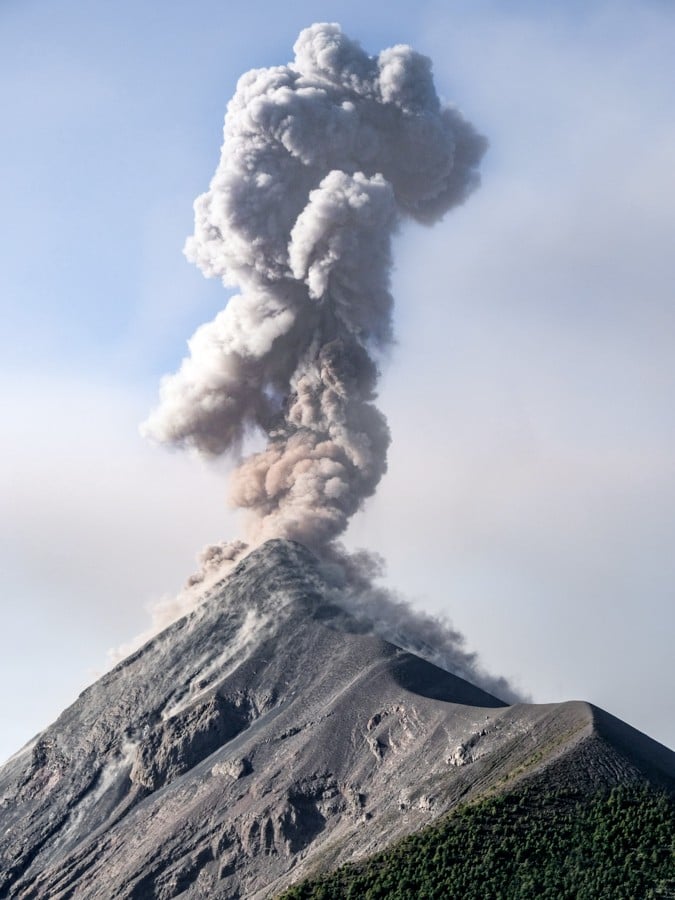
Volcán De Fuego views from Acatenango
Best Acatenango Volcano Tours
GetYourGuide has Acatenango trekking tours for 1, 2, or 3 days, where you can camp near the Guatemala volcano and watch the eruptions, plus some of them include the optional hike to Volcan De Fuego to see the eruptions even closer.
These tours are run by Old Town Outfitters in Antigua, Guatemala, and they have hundreds of positive Google reviews from happy customers of all nationalities. Other high rated tour companies for this hike include Wicho & Charlie’s, Soy Tours, Tropicana, OX Expeditions, and Tours & Activities SA.
We’ve used GetYourGuide for lots of tours and activities around the world, and they’re great. Highly recommended!
Book Now: Acatenango Volcano Tour 1 / 2 / 3 days
Where Is Acatenango & Volcan De Fuego?
The Acatenango volcano is located west of Guatemala City, overlooking the town of Antigua.
Most people base themselves in Antigua for this hike, since it has plenty of hotels and restaurants, and it’s only about 30 kilometers from the volcano (a 1.5 hour drive).
About Volcan De Fuego
The Volcanes De Fuego is the star of this hike. While Acatenango is an inactive volcano, Fuego is highly active and it sits right across from Acatenango, far enough to be safe for camping, but close enough to give you amazing views of the eruptions.
The Fuego volcano usually erupts once every 15 to 30 minutes, although it can sometimes do shorter or longer intervals. During my 3 day hike, it was erupting every 10 minutes on the first day. By the second day it had slowed down to every 30 minutes, and on the third day it was only erupting every hour, but each eruption was enormous.
The intervals are not completely predictable, but if you spend a couple days on the mountain summit then you can almost be certain that you’ll get to witness multiple eruptions.
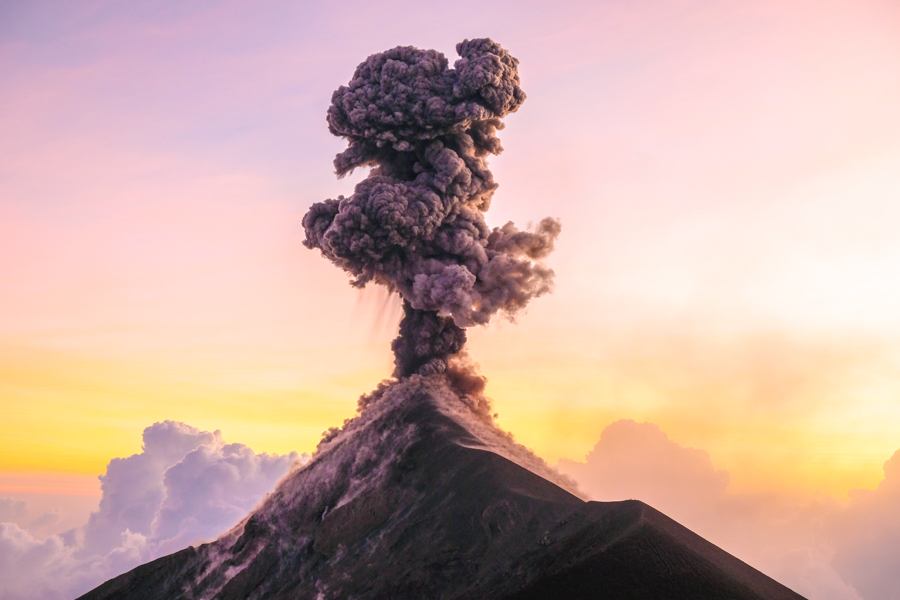
Volcanes De Fuego normally erupts every 15-30 minutes
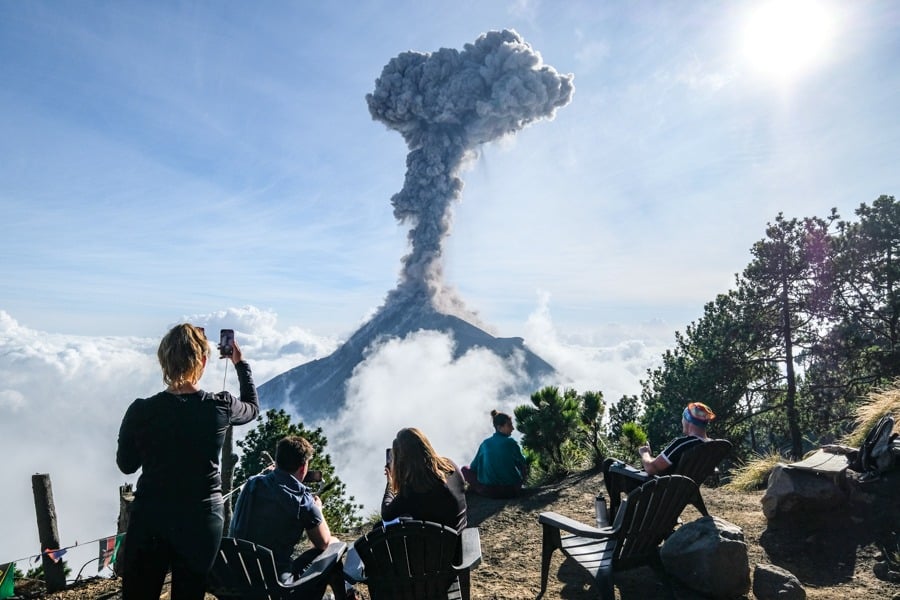
Watching the eruptions from Acatenango base camp
Acatenango Sample Itinerary
Here’s a sample itinerary for a 2 day, 1 night Acatenango volcano hike:
- 07:00 – Meet up for briefing, preparing gear, etc
- 08:00 – Transport by bus from Antigua to the trailhead
- 09:15 – Start hiking
- 14:00 – Reach Acatenango base camp
- 15:00 – Start the extra hike to Volcán De Fuego (optional) if weather is favorable
- 19:30 – Dinner at base camp
- 04:30 – Summit hike for sunrise (optional)
- 07:00 – Breakfast at base camp
- 08:00 – Start descending
- 10:00 – Reach the trailhead and start driving to Antigua
- 11:15 – Arrival in Antigua
Of course, this is just a sample itinerary and your trek may not go exactly like this, but the 2 day treks normally tend to follow this general pattern.
Acatenango Trekking: What To Expect
• Starting The Acatenango Volcano Hike
The Acatenango trek starts with a steep uphill walk on a dirt path that takes you through Guatemalan farmlands and jungle. The grade is tough and unrelenting from the beginning. In fact, this first section is actually one of the hardest parts of the hike!
The main path is never dangerous in terms of cliffs or drop-offs, it’s just a grueling workout. For most of the hike, you’ll also be hot and sweaty, and trying to shed every layer possible.
Once you reach the jungle, the grade is a bit more manageable and you have some nicer views, plus more shade from the sun. You’ll pass a couple of makeshift drink stands along the way, where you can buy snacks and drinks if you think you might need more.
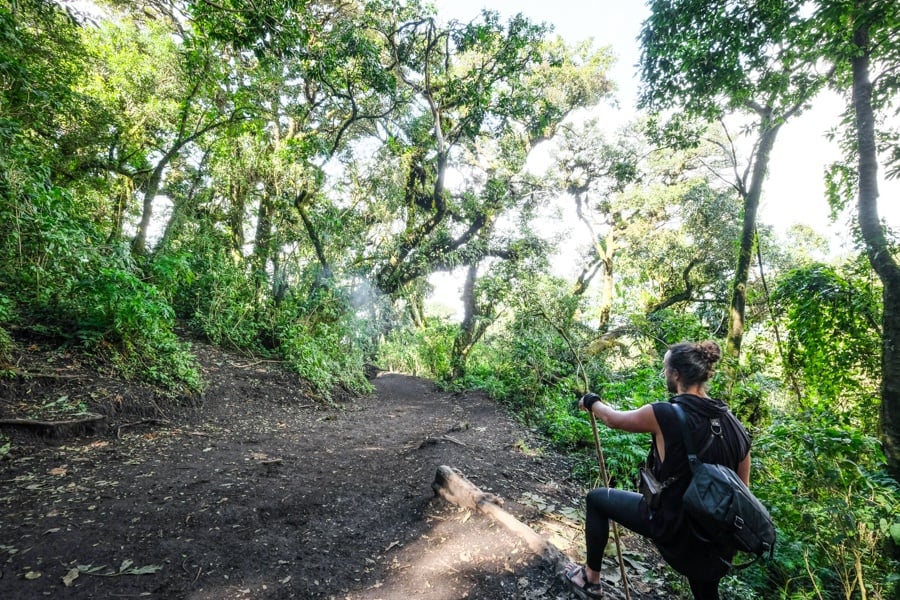
Jungle views at the start of the trail
• Acatenango Base Camp
After awhile, you’ll reach Acatenango base camp and witness your first eruptions from Volcan De Fuego in the distance! You’ll most likely hear it before you see it.
The size and amenities of your camp will depend on which trekking company you book with, and some are higher quality than others. A warm campfire is a given. Some companies even have little cabins, while others have tents.
This doesn’t make a huge difference since most people will only be staying one night anyway, and if we’re being honest you probably won’t get an amazing sleep regardless of how nice your camp is.
The important thing about base camp is that it has a direct view of the eruptions at Fuego — you feel like you can reach out and touch it!
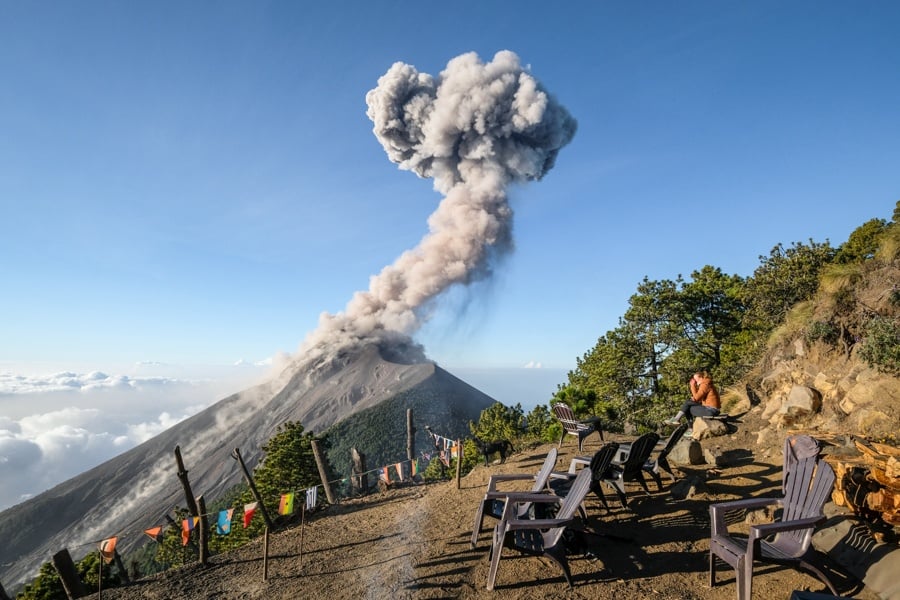
Chilling at Acatenango base camp
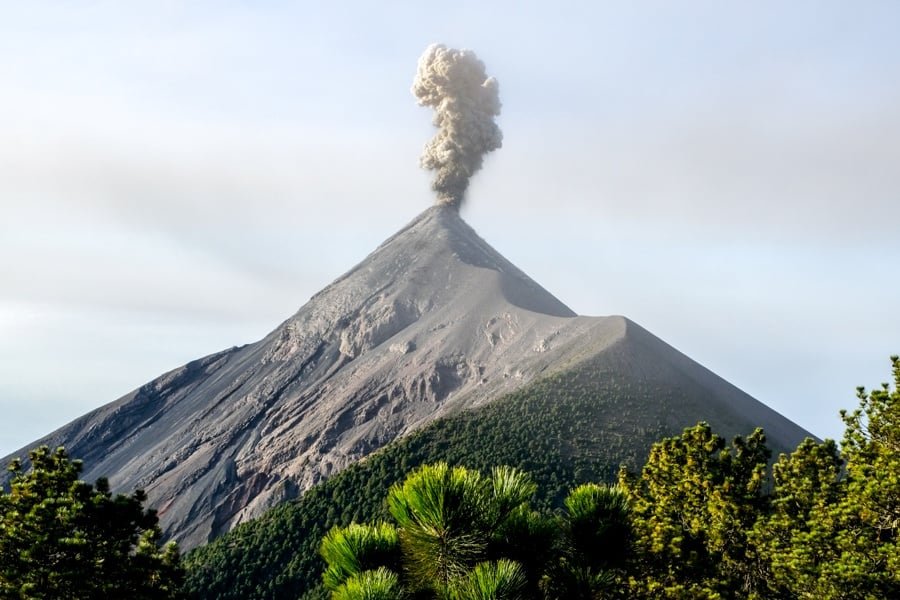
A new eruption starting
• Volcan De Fuego Saddle Hike
After you reach Acatenango base camp, your trekking company will usually give you an option to hike over to Volcan De Fuego and see the eruptions up close! This was the highlight of the whole trip for me. Roughly half of the trekkers in our group went on this expedition, and we were all so glad we did.
For this journey, you will temporarily leave the comfort of your beloved camp and hike down the steep and sandy slopes of Acatenango, cross the saddle between these two Guatemala volcanoes, and then climb up the side of the Fuego volcano until you’re standing on a flat ridge less than 1 kilometer from the eruptions.
At this distance, the eruptions sound like bombs going off, and you can feel the Earth rumbling under your feet. If you go in the evening, you can also see the red lava rocks exploding on the side of the mountain.
It’s impossible to describe how amazing this is, but it requires good fitness. You don’t need any technical skills for this part of the hike, but it’s still going to be very hard for anyone because you’re already exhausted from hiking to Acatenango base camp earlier in the day.
If you still have plenty of energy left over when you reach base camp, I would HIGHLY recommend doing the extra hike to Fuego. It’s one of the best things I’ve ever seen in my travels around the world.
This is one part of the hike where you’ll want to bring layers of clothing. It can get very cold on the Fuego saddle, especially in the evening if there’s a strong wind and the sun goes down. Come prepared!
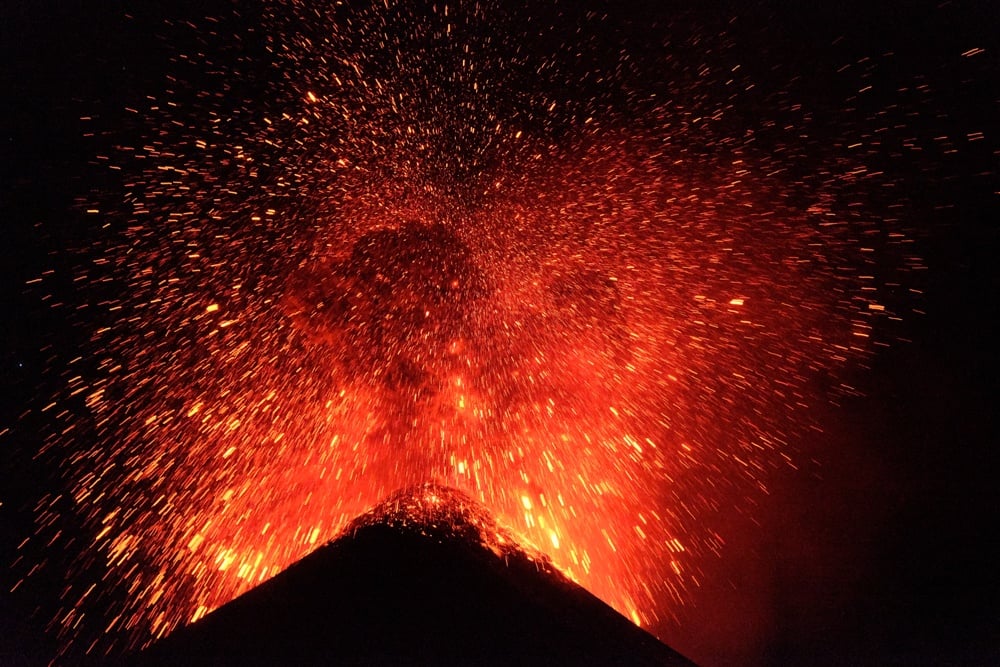
Red lava eruptions at night
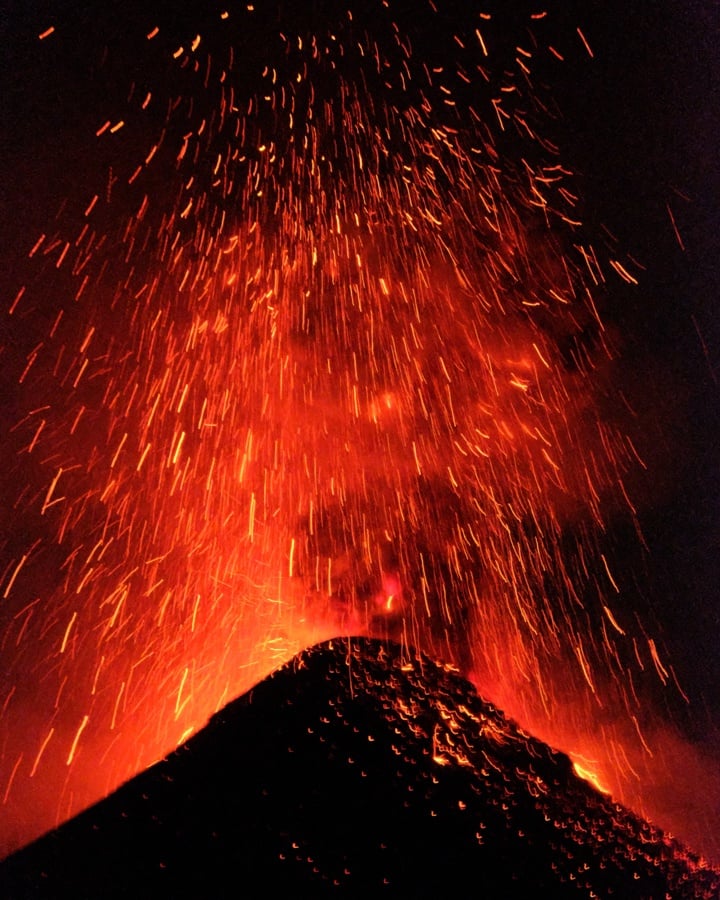
Volcano of Fire!
• Acatenango Summit Sunrise
Last, but not least, there’s the extra hike to the summit of Acatenango, which most trekking companies do at sunrise. That means a wakeup call at around 4:30 AM. This hike is not near as hard as the Fuego hike, but it’s still a good workout with plenty of slippery sand.
The sunrise on top of Acatenango is incredibly beautiful, with a sea of puffy clouds and great views of Volcan De Fuego erupting, plus you can usually spot Volcan De Agua in the distance.
If you want a picture of yourself (or your group) with the eruption behind you, the summit is one of the best places to do it! It’s very busy in the morning, but there’s more than enough room for everyone to stand and take their pictures.
The Acatenango summit is also one of the coldest parts of the hike. We even saw some icicles up there in December. There’s a lot of wind at the summit, but you can duck into the crater for shelter while you wait for sunrise, so it’s manageable.
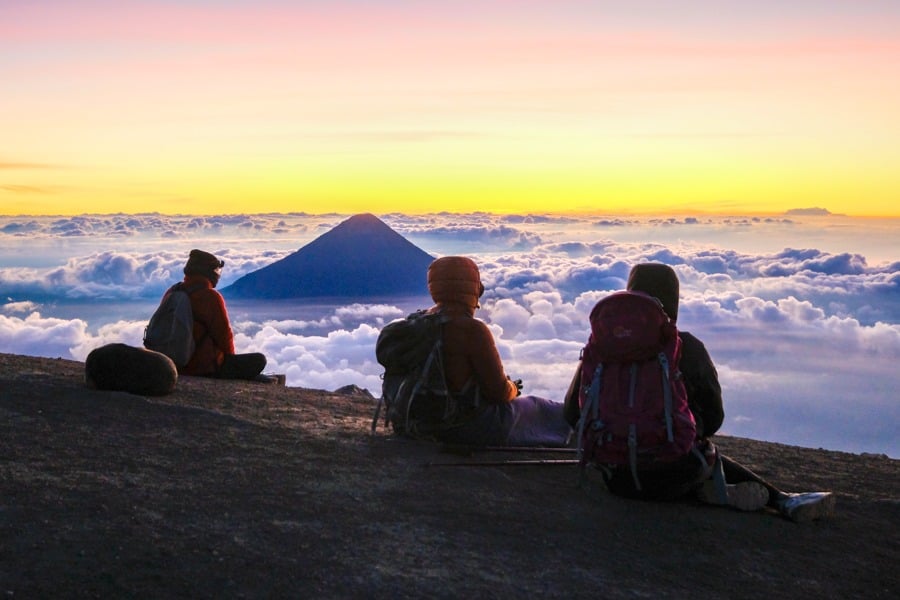
Waiting for sunrise at the Acatenango summit
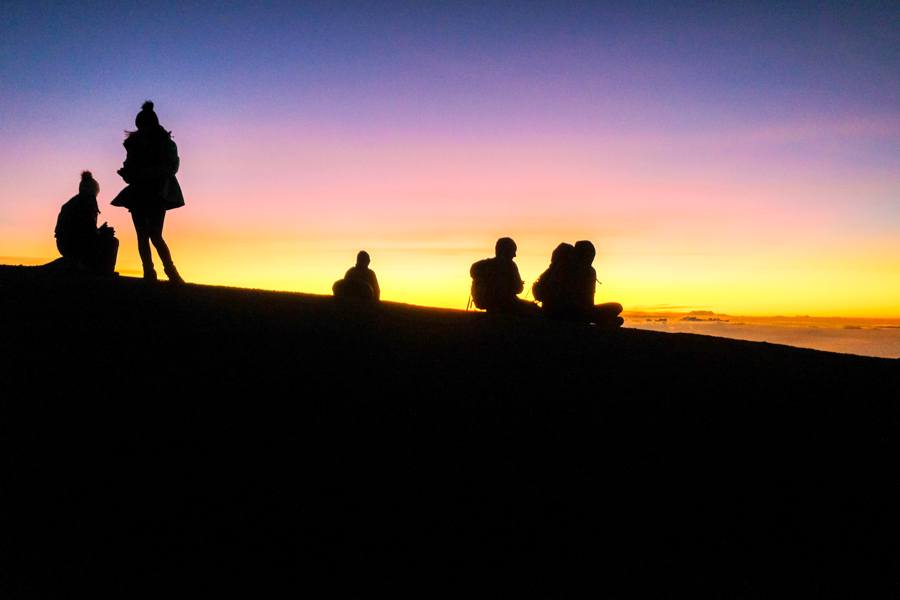
First color
• Acatenango Hike Difficulty: How Hard Is It?
The Acatenango hike is hard. Very hard. The overall combination of high altitude, a very steep grade, loose rocks that sink under your feet like sand, and cold weather all come together to make this a really tough one.
However, even if you only make it to base camp, the hike is still worth it. You can see amazing views of the eruptions from the camp site, so it’s not really necessary to do the extra hike to Fuego or to the Acatenango summit unless you still have energy and want to see the action even better.
You don’t have to be super fit to make it to Acatenango base camp. The guides give you plenty of breaks along the way, so you can go at your own pace. We had several people in our group who were definitely out of shape, and they still made it to base camp just fine.
Another way you can make the hike easier is to hire a local porter to help carry your stuff. The price for this is around 150 Quetzales ($20 USD) depending on the weight of your bag, and they will carry up to 13 kilos (30 pounds) for you up the mountain.
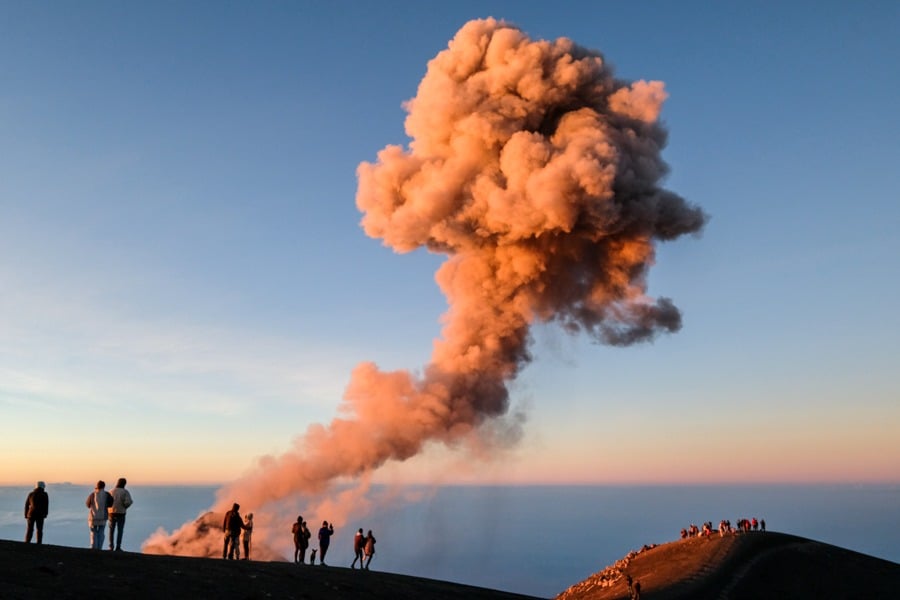
Eruption views from the summit. One of the best parts of the Acatenango hike.
• Acatenango Distance & Time
The one way hiking distance from the trailhead to Acatenango base camp is about 4 miles, and it normally takes 4 or 5 hours depending on your pace.
If you decide to go from base camp to the summit for sunrise, that takes another 1 to 1.5 hours. Going back down from base camp to the parking lot is a lot quicker and easier, and only takes 2 or 3 hours.
If you decide to do the extra hike from Acatenango base camp to the Volcan De Fuego saddle to see the eruptions up close, that adds another 3 miles (roundtrip), which takes about 4 hours total. It’s tough. We all struggled with it.
All in all, if you do the entire hike to the Acatenango base camp, summit, and Volcan De Fuego saddle, you’re looking at 10 to 13 hours of total hiking. That’s no joke. However, if you only go to Acatenango base camp and skip the other sections, it’s quite a bit easier.
The good news is that you don’t have to make any kind of booking for the extra hikes. You can wait and decide if you want to do them after you reach base camp. If you’re not feeling it, you can rest at the camp instead and enjoy the Guatemala volcano views.
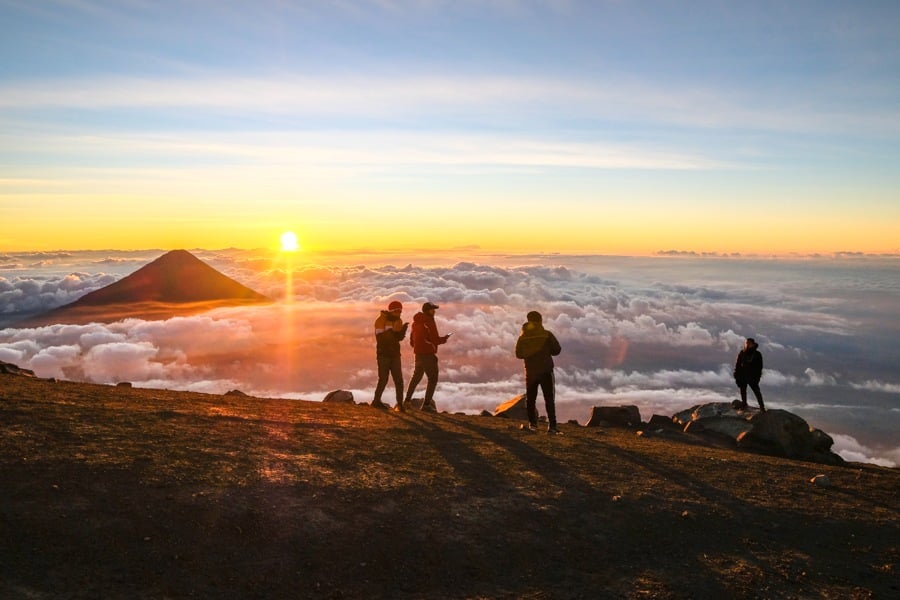
Sunrise at the summit of Acatenango
• Acatenango Elevation/Height
The Acatenango summit has an elevation of 3,976 meters (13,045 feet) above sea level, and the Volcan De Fuego has a slightly lower elevation of 3,768 meters (12,362 feet). Base camp is around 3,500 meters (11,000 feet).
That means there’s less oxygen, and when you’re hiking, you’ll be huffing and puffing to catch your breath with each step. It definitely adds an extra layer of challenge to the hike.
The elevation at Acatenango is high enough to cause altitude sickness (AMS) for some people, so you might run into at least some degree of headaches, crappy sleep, etc. If your symptoms get too severe, you may have to descend and go back to a lower altitude.
I haven’t heard of people getting dangerously sick with AMS on the Acatenango volcano hike, although I wouldn’t completely rule it out. We had one young guy in our trekking group who was throwing up a lot, but he improved right away when we descended the next day. Keep in mind, your likelihood of getting AMS is not affected by age or physical fitness. You can be young and perfectly fit, and still get altitude sickness.
If you’re coming from sea level, it’s recommended that you spend at least 48 hours in Antigua before the hike to help you acclimatize to altitude. The town of Antigua is 1,545 meters (5,069 feet) above sea level, and Guatemala City is about the same, so being in one of those places gives your body a chance to adjust a little bit.
With that said, I’ve heard of many people doing the Acatenango hike without much acclimatizing at all, and they were still fine. I did the hike with two different groups of 20 people, and most of us had only minor AMS symptoms. Plus, if you do a day hike at Acatenango instead of overnight camping, then it’s not really a concern anyway. You’ll be on the way back down before you even start to feel the effects.
Staying hydrated is supposed to help with altitude sickness. You’ll want to drink lots of water before and during the hike. You’ll also want to avoid alcohol, caffeine, cigarettes, and sleeping pills because they can make the symptoms worse.
If you have spare time before the Acatenango hike, a great warmup hike to do for acclimatizing is the Pacaya volcano trek, which is another one near Antigua. It’s not as spectacular as Fuego and you can’t usually see active eruptions, but it’s still a fun way to train.
The Pacaya hike is easier, shorter, and cheaper than the Acatenango volcano hike, but it still has a high enough elevation to help adjust your body to altitude. Pacaya’s summit is 2,552 meters (8,373 feet), although most tours don’t go all the way to the summit. You can book the Pacaya trek online here.
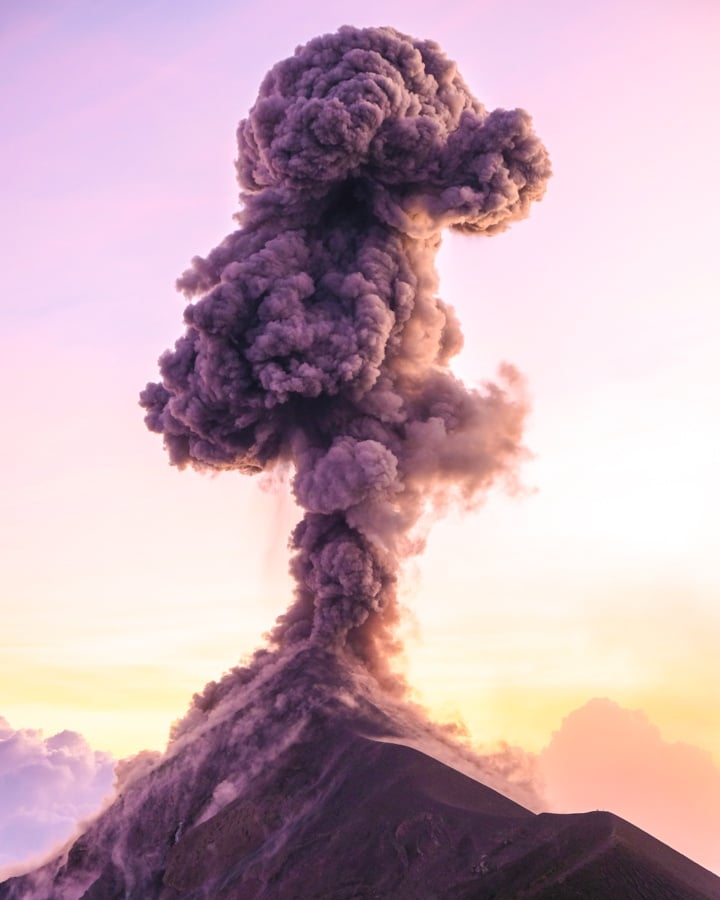
Boom! Acatenango volcano hike
• Acatenango Elevation Gain
The vertical elevation gain on the hike to Acatenango base camp is about 1,110 meters (3,650 feet). If you include the summit push, it’s a whopping total of 1,615 meters (5,300 feet). More than a mile straight up!
If you do the extra hike to the Volcán De Fuego saddle, that adds another 480 meters (1,600 feet) roundtrip, because you’re going downhill and uphill both ways when you walk between the two volcanoes.
In total, if you do the entire hike to Acatenango summit plus the Fuego saddle detour, you’re looking at a grueling elevation gain of almost 2,100 meters (7,000 feet)! Insane!
• Acatenango Weather
The daytime temperatures at Acatenango base camp are pleasant and even warm if the sun is shining. However, the temperatures overnight can get quite a bit colder than in Antigua or the rest of Guatemala.
In the day time when you first start the hike from Antigua, it may be a nice warm 70 °F (21 °C), but by night time at base camp it can drop below 32 °F (0 °C), and in some cases can even get as low as 23 °F (-5 °C). It can also be very windy, especially at the summit for sunrise.
On January 8, 2017, six Guatemalan tourists died of hypothermia on the Acatenango volcano hike after they came unprepared and got caught in a severe cold snap. I don’t want to scare you by mentioning that, and the trek is plenty safe as long as you’re prepared, but don’t underestimate the cold!
Most tour companies will provide you with plenty of warm weather gear to borrow, rent, or buy for the Acatenango hike, so you’ll definitely want to take advantage of that. You might also want to keep an eye on any unusual weather warnings for the day you hike, although it’s rare and your guides will probably stay on top of that for you.
You can check a weather forecast for the Acatenango mountain summit here, including factors like wind, rain, clouds, and temperatures. This should be a bit more accurate than the average weather report, although it’s still not perfect, so keep that in mind.
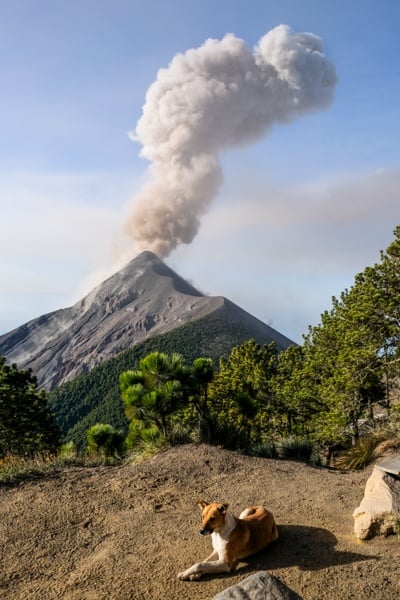
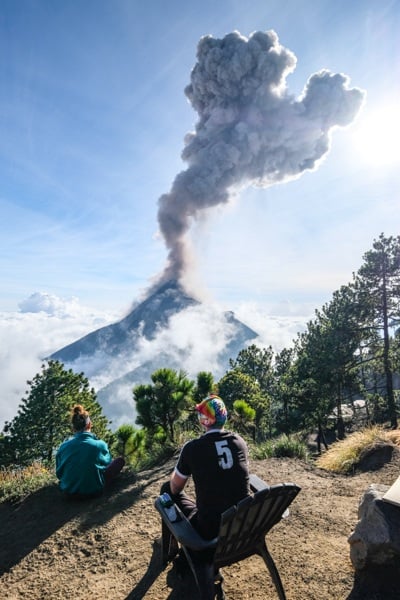
What To Bring
- Layers: Bring a good jacket and extra layers for the Acatenango hike. I had a t-shirt, two sweatshirts, and a light down jacket. However, you’ll want to start the hike in a t-shirt and wear the layers later.
- Headwear: You’ll want a warm beanie hat that covers your ears.
- Gloves: I wore fingerless gloves so I could work my camera while still staying reasonably warm. My hands were the coldest part of my body on this hike.
- Footwear: Hiking shoes with good grip are ideal for the Acatenango volcano hike. You’ll be walking on slippery gravel and steep inclines or declines at times.
- Poncho: If you climb Acatenango or the Fuego volcano during the rainy season (especially June through September), you will definitely want to bring a rain jacket just in case.
- Water: There’s no potable water source on the mountain. Bring more water than you think you’ll need. Guides will advise you to bring at least 4 liters of water for the Acatenango hike, and another 500 mL if you plan to do the extra Volcan De Fuego hike to the saddle.
- Snacks: Again, even though most tours include free meals, the quality varies and you may still be hungry after such a whopper hike. I brought snack bars and beef jerky from the U.S. so I would have something extra. I ate all of it and wished for more. YMMV.
- Headlight: Acatenango trekking tours will provide cheapo headlights, but you’ll at least want to bring some extra batteries. A headlight is absolutely required for the Fuego saddle hike and also the Acatenango summit, because you could get hurt if you’re walking in the dark.
- Powerbank: If you plan to use your phone for taking pictures or as a flashlight, then you might want to bring a small power bank. I like Anker, they’re tough and high quality.
- Camera: Any camera with a bit of zoom is ideal, so you can take great pictures of the Volcan De Fuego eruptions from Acatenango base camp. Most of my pics on this page were taken with a kit lens. If you do the extra hike over to the Fuego saddle to see the eruptions up close, then you’ll probably want to switch to a wide angle lens for that.
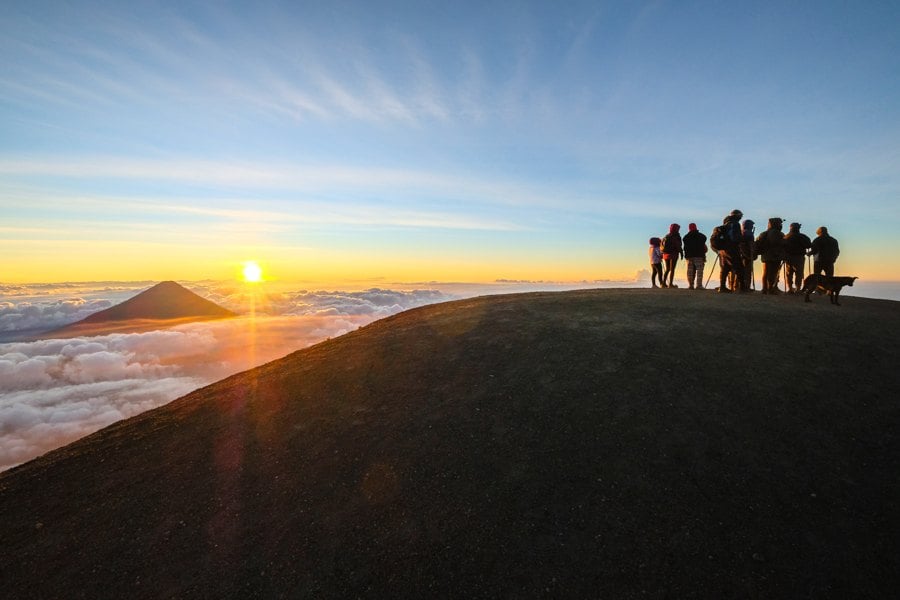
Normally the best time to hike Acatenango is during the dry season, but you can hike it all year round.
Best Time To Hike Acatenango
The best time to hike Acatenango is during the dry season in Guatemala, which runs from November to April. It’s clearer and less likely to rain during these months, so overall it’s a great time for mountain trekking.
The rainy season in Guatemala runs from May to October, and there is quite a bit more rainfall, but it tends to come in the afternoon. Mornings and evenings are usually clear, even in the rainy months. This season may not be ideal for trekking Acatenango, but you can definitely do it. You’re just more likely to get wet.
As always, since you’re dealing with a mountain, the weather isn’t completely predictable at any time of year, and you could have bad weather in the dry season or good weather in the rainy season.
If you’re worried about clouds blocking your view of the Fuego eruptions, I would book a longer Acatenango trip so you have more time at the summit and more chances to see the fireworks.
In conclusion, dry season is best for trekking Acatenango if you have a choice, but it can be hiked at any time of year, and the small eruptions are happening at Volcan De Fuego all year round except for occasional brief pauses.
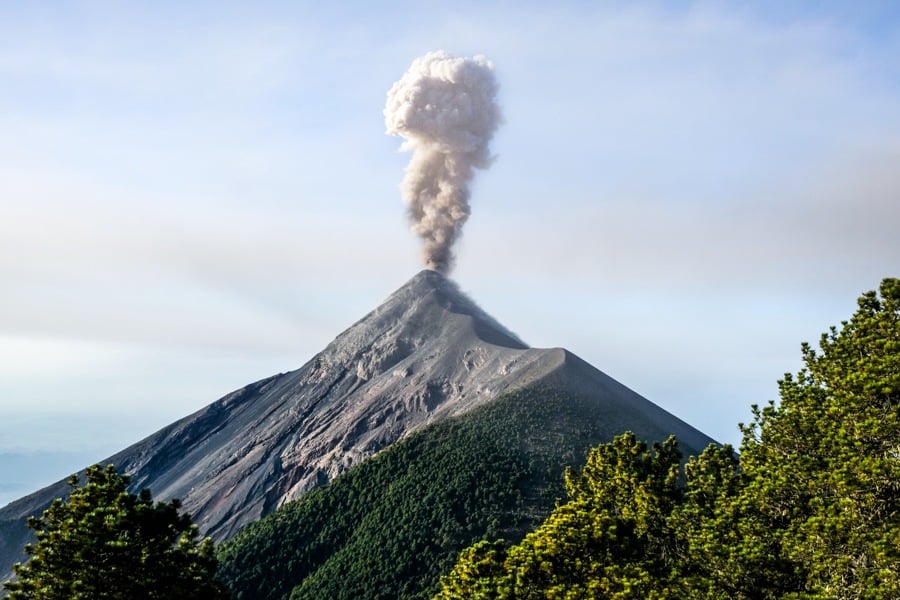
Fuego views
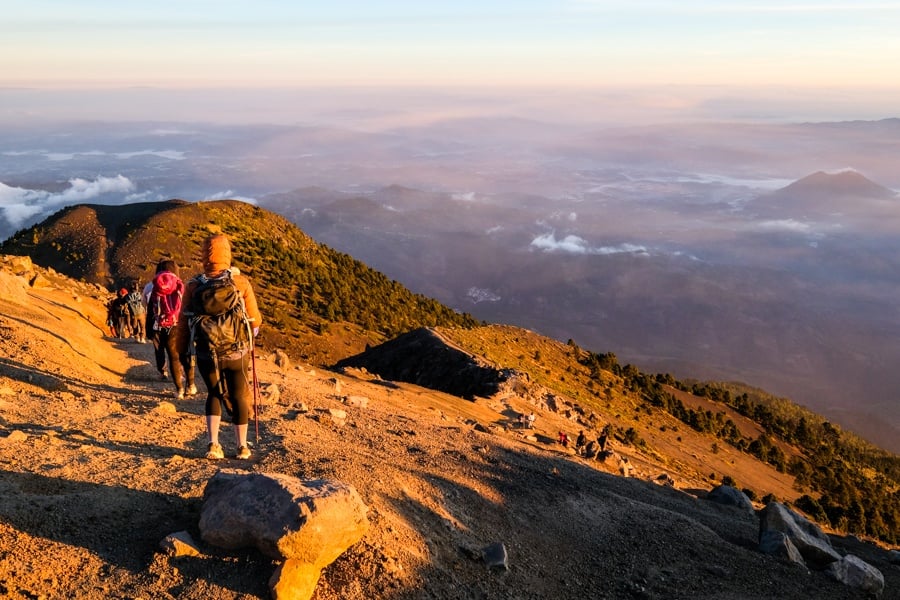
Going back down the mountain
Acatenango Deaths & Safety
The safety record on the Acatenango volcano hike is pretty spotless so far. I don’t know of any deaths or injuries from the volcano in the many years it’s been open for trekking.
Of course, there is always going to be some risk involved in hiking near an active volcano, but the camp is located well away from the eruptions, so you’re not really in the line of fire even if there was some kind of major eruption.
If you want to be super careful, you could skip the extra hike to Fuego and just watch the eruptions from base camp instead. I’ve never heard of anyone getting hurt on the Fuego hike, but that would probably be the most likely place for something to happen.
The other question is robbery. As you might know, Guatemala is not the safest country in the world, and there was a rash of armed robberies on the Acatenango hike back in 2007-2009. However, it seems like safety has improved on the hike ever since they started charging an entrance fee, and I haven’t heard of any crimes like that happening here in at least a decade.
This mountain is providing a lot of income for the local communities in Guatemala nowadays (easily millions of US dollars when you add up all the trekking companies and entrance fees), so it’s in everyone’s best interest for them to let tourists hike in peace and not do anything to disturb the cash cow.
If you want some extra peace of mind, you could also bring a hidden travel belt (like this one on Amazon) and put some of your valuables in it. That’s what I did. During the first part of the hike, the views are pretty boring so I stowed my phone, cash, and credit card in a hidden belt to be extra safe.
With that said, it was a great hike and we didn’t have any crime issues at all. Even though Guatemala doesn’t have a very good reputation on safety, I think it’s improved a lot in the last 20 years, and still seems to be getting better.
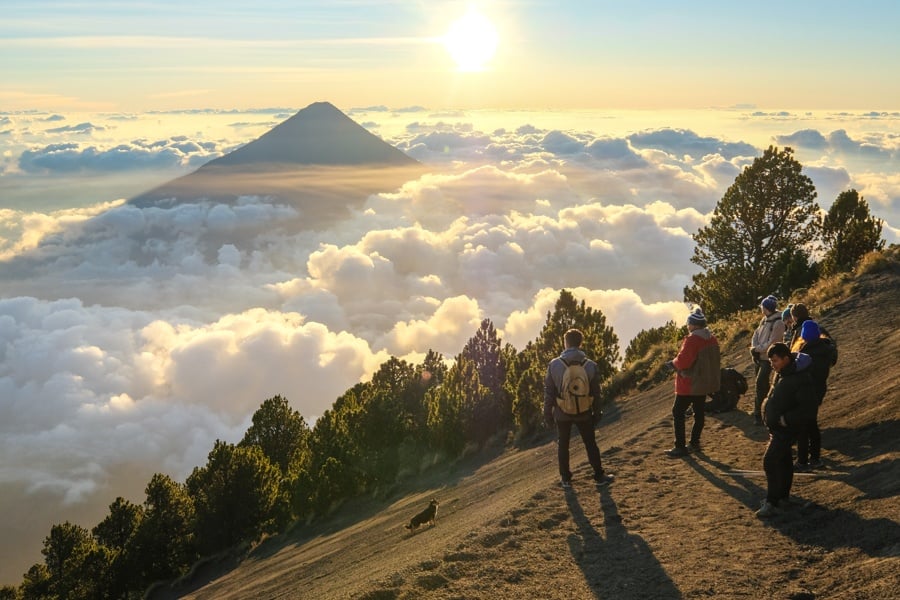
Sunrise views with Volcan De Agua in the distance
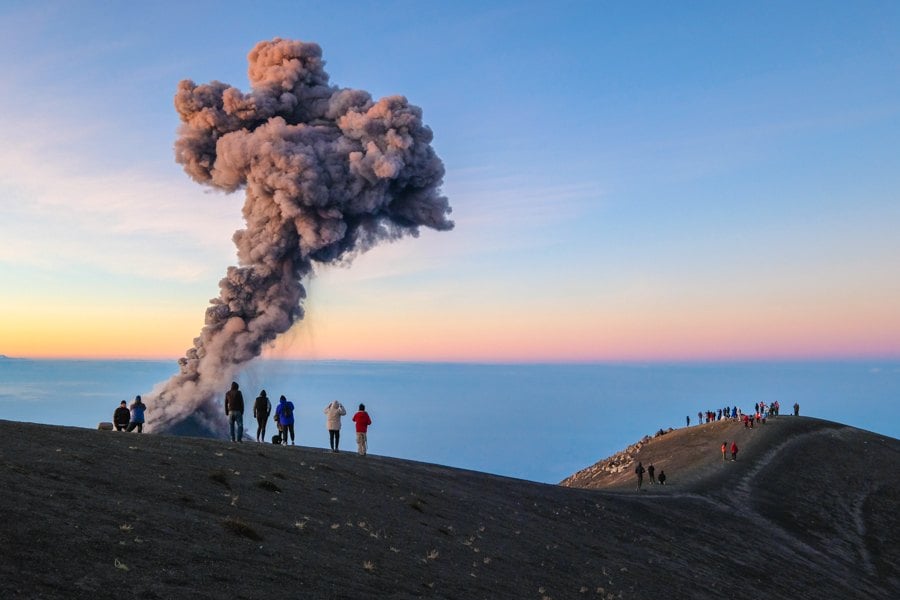
A spectacular show on the Acatenango hike
Other Tips For The Acatenango Hike
- Bugs: We didn’t have any problems with mosquitoes or other bugs on the Acatenango hike. The elevation is too high for mosquitoes so it’s not something to worry about. I didn’t even bring spray.
- Cell Service: I had a little bit of cell service/phone reception at Acatenango base camp with Claro and Tigo via my T-Mobile roaming package, and occasional spotty reception on the hiking trail itself. It was good enough to send occasional texts to my family and let them know I was okay, but it wasn’t anything very reliable. I’m sure this also depends on where your base camp is located on the mountain, so some treks may not have any reception at the camp.
- Drones: You can fly drones at Acatenango, and there aren’t any restrictions that I know of. I saw several tourists doing it. However, it can be a bit tricky with the wind, so you’ll want to keep that in mind. Plus there are lots of other people camping on the mountain, so you’ll want to be considerate and keep some distance.
- Entrance Fee: The current entrance fee for trekking Acatenango is 110 Quetzales ($14 USD) per person. You pay this at a Guatemalan government booth partway through the hike. However, your trekking company may already include this fee in the total price of the hike, so that’s something you can check.
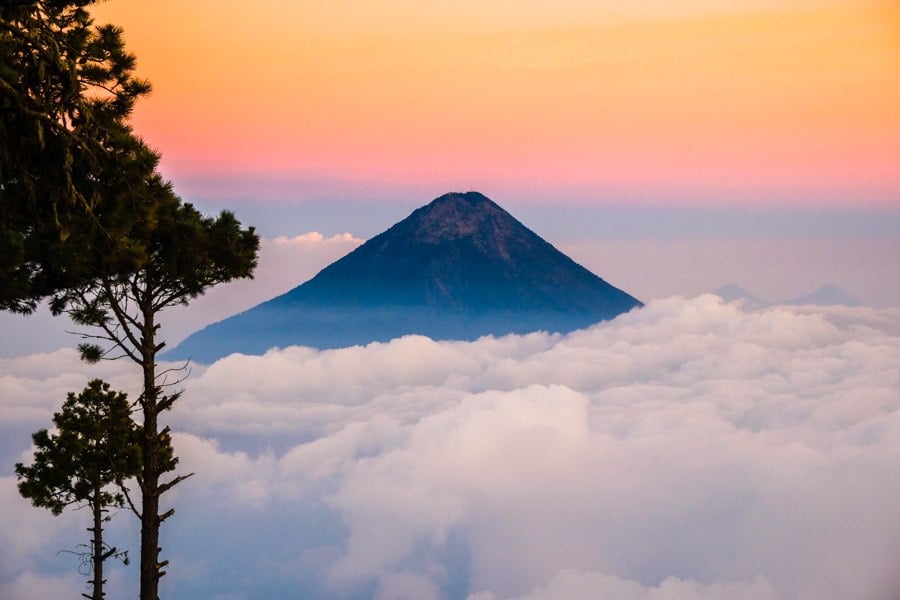
Sunset views of Volcan De Agua in the distance
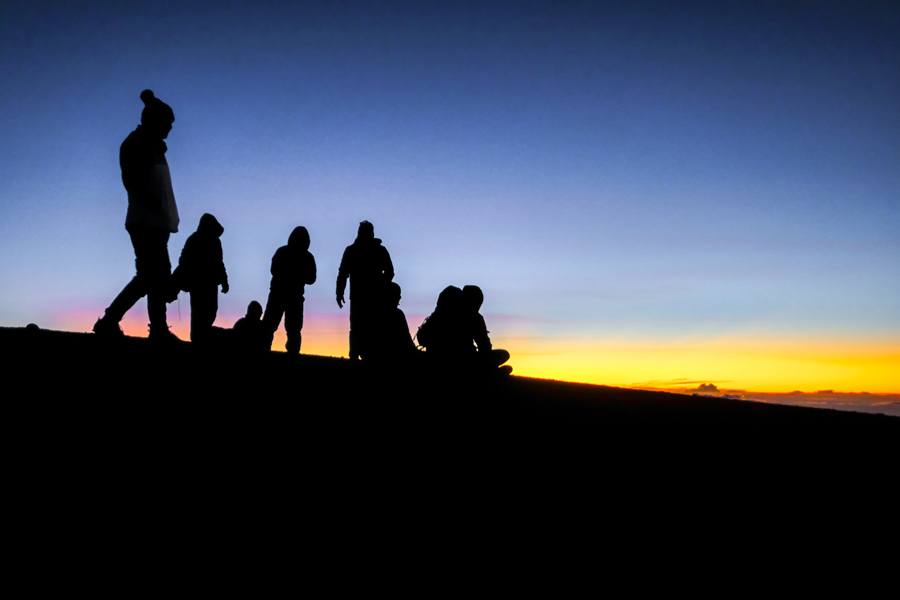
Before the sunrise
Hiking Acatenango Without A Guide
For the average hiker, there are many reasons I wouldn’t recommend hiking Acatenango without a guide: navigation, logistics, convenience, safety, etc. You’ll have a much better and more enjoyable experience if you book a guided tour and go with a group of fun likeminded people.
With that said, it’s certainly possible to hike Acatenango without a guide if you’re determined and have prior experience with the route. One of the challenges will be finding a good spot to camp, since I’ve heard the trekking companies are pretty territorial about space on the mountainside.
Is The Acatenango Hike Worth It?
Yes, the Acatenango volcano hike is absolutely worth it! It’s bucket list material. Truly a once in a lifetime experience.
Even though the hike to Acatenango and Fuego is one of the hardest hikes I’ve done, the payoffs match the difficulty. In my opinion, there is no question that this is one of the top 10 best hikes in the world. It might even be in the top 5 for me.
To stand next to an erupting volcano, feel the rumbling in the ground, and watch the exploding lava rocks is just priceless. Outside of Guatemala and Indonesia, I’m not sure if I know of any places in the world where you can do that.
Is Acatenango Open / Closed?
Yes, Acatenango is currently open to tourists! I’ll update this travel guide if anything changes.
The mountain is rarely closed to the public, and that would generally only happen temporarily if there’s some kind of extremely unusual volcanic activity or other safety concerns.
Happy travels!
Antigua Hotels
More Guatemala Travel Tips
Thanks for looking! I hope you enjoyed this volcano trekking guide for the Acatenango hike and Volcan De Fuego in Guatemala.
Don’t forget to check out my guide for Tikal National Park in Guatemala before you go!
Happy travels!




1 comment
Would love to camp here! Thank you for the article.